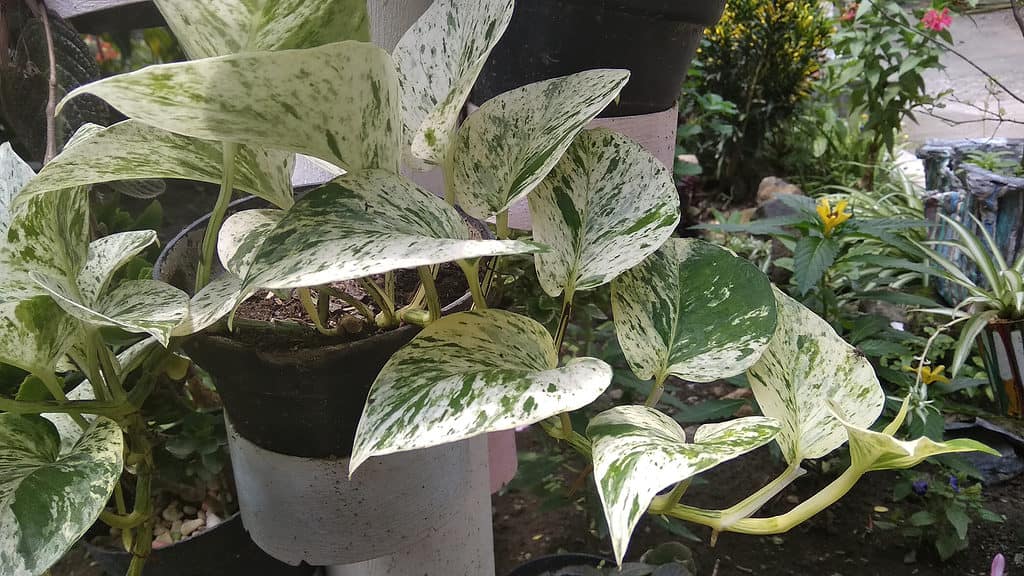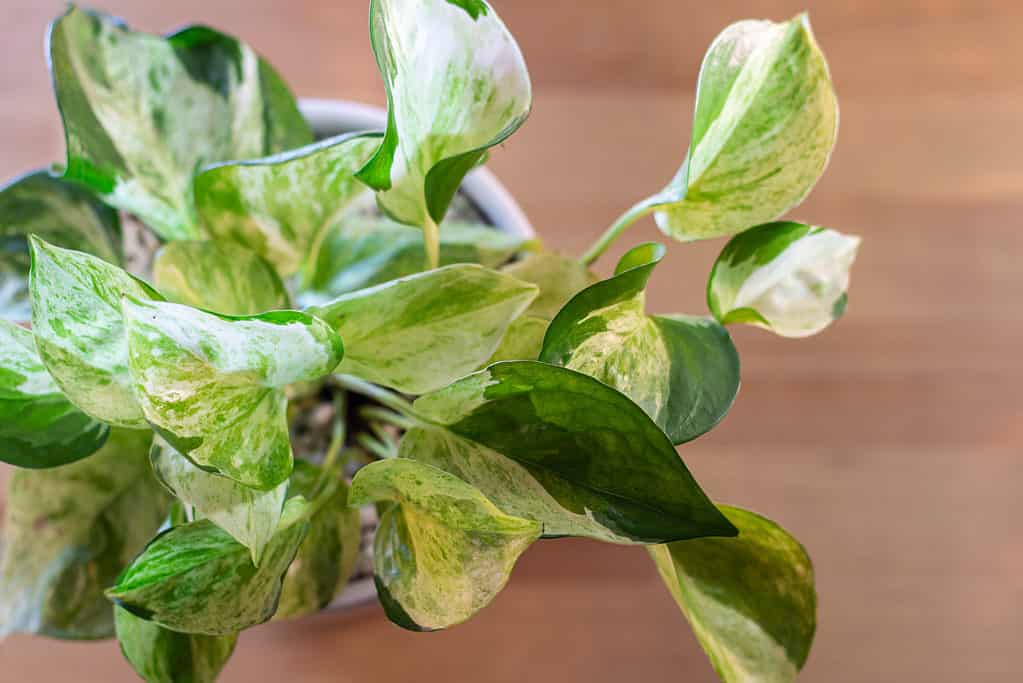One of the best things about pothos plants is the sheer volume of varieties out there. With 15 different pothos species and dozens if not hundreds of varieties in those species, there are certainly many to choose from. These varieties contain many different types of foliage hues, variegation, growth habits, and overall aesthetics. One specific group of pothos varieties that are quite popular are white pothos or pothos plants that have white or pale variegation. Choosing the right pothos for your home might be a bit tricky, but we’re here to help.
In this article, we’ll take a look at some of the most popular, stunning, and rare white pothos varieties and cultivars that you can get your hands on.
What is White Pothos?
A white pothos is simply any variety of pothos that has pale green or white variegation in its leaves. Variegation occurs when specific genetic breeding practices result in plants that lack chlorophyll production in certain areas of the plant, such as part of its leaves. The result is simply the absence of color in different patterns, such as splotches, stripes, veins, etc. Variegation doesn’t hurt the plant; in fact, variegation can occur in nature and affect virtually any plant. The results are simply beautiful patterns that make white pothos plants coveted by collectors.
It’s worth noting that there is no white pothos plant that is completely 100% white. That would mean the plant lacks chlorophyll altogether, which it needs to survive. However, there are many cultivars that have more white than green in their leaves.
With this in mind, let’s check out a few well-loved white pothos varieties.
Snow Queen Pothos
Scientific Name: Epipremnum aureum ‘Snow Queen’
When it comes to white pothos, the most common variety has to be the Snow Queen pothos. This variety is extremely comparable to the Marble Queen pothos (which we’ll discuss next), but Snow Queen has much more constant white variegation, hence the name. This pothos is a true beauty among pothos cultivars! The leaves of this plant lack chlorophyll and develop considerably more slowly than lush green cultivars, like other white pothos do. Give it a little bit more sunlight than you would the Marble Queen or the green-leaved pothos to give it a boost in terms of growth.
This variety’s leaves are predominantly white or pale green variegated, with some green in the form of large white splotches. Indirect sunlight that is bright works best for this slow-growing cultivar.
Marble Queen Pothos
Scientific Name: Epipremnum aureum ‘Marble Queen’
Another well-known white variation of this tropical plant is Marble Queen pothos. It is one of the first pothos cultivars ever made and stands out from golden pothos and other non-variegated varieties. The leaves of this variety feature spots of white and green that resemble that pattern often found inside glass marbles. Some leaves and plants may have a nearly equal distribution of the two hues, while others may have more white or more green. Because it has less chlorophyll than other pothos kinds, it develops much more slowly, not unlike the Snow Queen variety. It is the perfect table plant because of this and its remarkable appearance. It is quite valuable as a collector’s plant in terms of aesthetics.
Be cautious with the light levels when caring for this plant. The Marble Queen will become green and lose its whiteness if it receives insufficient light. This is because it will begin to produce chlorophyll to make up for the lack of light. This also applies to other white pothos plants as well.

The white variegation of the Marble Queen pothos (pictured) has made it quite popular among plant enthusiasts.
©Rezqiano/Shutterstock.com
Trebi Pothos
Scientific Name: Scindapsus pictus ‘Trebi’
Another honorary member of the pothos family is the Trebi pothos. In actuality, the fact that it belongs to a different genus is concealed by its common name. You will almost always find it with the label “pothos” on its container at garden centers. Nevertheless, they do resemble pothos quite a bit, and they are cousins in the same plant family, so we will go ahead and add this species to our list of beautiful white pothos.
The back lobes of the Trebi pothos’ leaves are not particularly prominent, and the heart-shaped leaves are more lanceolate in form. This trailing vine’s leaves feature a lovely pattern of two shades of green and silver. The silver appears as spots, blotches, and patches in the main deep green, which appears to be the foundation or base hue.
Because of its detailed variegation, this is a plant you’ll want to keep on a desk at eye level to really enjoy. It looks fantastic against backgrounds that are either dark or light. This plant could be difficult to locate at local garden centers or nurseries, but if you do, always lay the leaf design against a monochromatic background to bring out the most in it.
Manjula Pothos
Scientific Name: Epipremnum aureum ‘Manjula’
The Manjula pothos is a unique cultivar with an oddly-shaped leaf. They have the typical pothos heart-shaped form, but unlike other varieties of this houseplant, they bend at the tips rather than remaining flat. The University of Florida developed this cultivar and still maintains the patent for it. Because of this, those who purchase Manjula plants are not permitted to reproduce them.
The leaves’ varied hues, which range from white to green to silver and cream, are quite beautiful. These overlapped hues can appear in various patterns. Some end up resembling abstract paintings or even spiderwebs in nature.
Remember that this is a somewhat uncommon variety. Be very cautious if you manage to locate it since it is more expensive than other varieties of pothos. If you don’t care for it properly, you could lose a pretty penny! Be mindful of sunlight exposure as too much or too little might change the variegation of the plant. Move your Manjula pothos around if required to ensure it gets the right amount of light, around four to six hours of bright, indirect light.

Manjula pothos (pictured) is a rare variety when compared to many other white pothos varieties.
©Catherine Tribone/Shutterstock.com
Hawaiian Pothos
Scientific Name: Epipremnum aureum ‘Hawaiian’
The Hawaiian pothos has a really special appearance. It has broad, glossy leaves with varied patterns, as many variegated white pothos varieties do. The majority of the leaf is covered with a deep emerald green tint, which is the dominant hue. However, there are splotches of paler yellow-green and silvery cream that trace the lateral veins and draw attention to the leaf margins. It also develops aerial roots on the stems, further enhancing the vibe of a tropical forest. If that’s the kind of look you’re going for, this is the white pothos variety to pick.
This is one of the best pothos kinds to combine with other broad, showy leaf plants to create a rainforest nook in your living room. Regular pruning will make the leaves thicker and improve the lush, tropical forest appearance that this plant is so fantastic for.
Glacier Pothos
Scientific Name: Epipremnum aureum ‘Glacier’
One smaller white variegated version of the pothos plant is called Glacier pothos. Due to its remarkable qualities, this cultivar is becoming increasingly widespread in garden centers and is popular among plant parents. Its modest size makes it perfect for office desks and coffee tables.
Having said that, the color pattern on the leaves of this pothos is its most lovely aspect. They feature large, delicate-appearing, and well-defined areas of emerald green and milk white along their wide leaves. It is understandable why this eye-catcher is the pothos family’s rising star.
Trim the Glacier pothos frequently for a fuller appearance. Additionally, be cautious when using low light since the white will disappear and the green will dominate, defeating the purpose of this cultivar’s look.

The Glacier pothos (pictured) tends to have more yellowish or cream variegation than white.
©Willowtreehouse/Shutterstock.com
Pearls and Jade Pothos
Scientific Name: Epipremnum aureum ‘Pearls and Jade‘
A patented variation of the Marble Queen pothos is the absolutely stunning Pearls and Jade variety. The leaf patterns resemble those of a N’Joy pothos. With white or cream variegation along the borders and green splashes or stripes on the white parts, this cultivar features dark green and silvery green leaves. But unlike other pothos varieties and species, this one received assistance in creating its distinctive leaf color and form.
This cultivar’s history is pretty remarkable. In the Florida Division of Plant Industry’s research facilities, scientists subjected a plain-looking Marble Queen pothos to gamma radiation in order to create this cultivar. The plant tissue underwent genetic alterations as a result, and the Pearls and Jade pothos was formally born about a year later. How cool is that?
Albo-Variegata Pothos
Scientific Name: Epipremnum pinnatum ‘Albo-Variegata’
Epipremnum pinnatum ‘Albo-Variegata’ is actually a variegted cultivar of the Dragon Tail pothos. It is one of the most uncommon types of Epipremnum pinnatum. When mature and well-established in terms of health, specimens of this variety can fetch hundreds of dollars on the plant market. Give this pothos a pole so it can grow with more structure, especially if you want to preserve its unique leaf size and form.
This variety’s leaves will often have vivid, stark-white spots that are contrasted with swaths of deep green, light green, and pale silvery-green. Just be sure to provide this cultivar with strong, indirect light, or else it can completely lose its color pattern. If you want as much white as possible on your pothos’ leaves, this variety is unquestionably what you should pick for your collection.
N’Joy Pothos
Scientific Name: Epipremnum aureum ‘N-Joy’
The youngest entry on our list of white pothos varieties is the N’Joy pothos. This pothos cultivar is among the most recently developed. This variety has distinct white and green spots. The white spots are usually big, inky patches that appear randomly along its leaves. Depending on the amount of light and the age of the leaf, the green will range in hue from pearly light green to deep forest green.
This variety’s leaves can assume quite unique forms. You could see a flame within a heart, a painted green ivy leaf on a white backdrop, or any other unique pattern. Looking at a N’Joy pothos is kind of like looking for shapes in clouds.
Despite being quite decorative, you could have trouble finding this very rare pothos variety. However, if you do, here is your chance to get a head start on a variety that is expected to gain in popularity over the next several years. Try looking online if you’re having trouble locating it.
Aren’t these white pothos varieties simply stunning? Some might be harder to find at your local nursery than others, but with so many options, you’ll definitely be able to find the perfect pothos for your plant collection.
Want to learn more about the eye-catching pothos houseplant? Check out our in-depth guide to everything you need to know about pothos!
The photo featured at the top of this post is © Rezqiano/Shutterstock.com
FAQs (Frequently Asked Questions)
Is there a completely white pothos?
No. All pothos has some type of green in them, as they need chlorophyll to survive.
Are white pothos rare?
Some white pothos cultivars are rare, but most are quite easy to find.
Is it normal for a green pothos to turn white?
A green pothos can turn white or pale when it has too much exposure to sunlight.
Thank you for reading! Have some feedback for us? Contact the AZ Animals editorial team.






